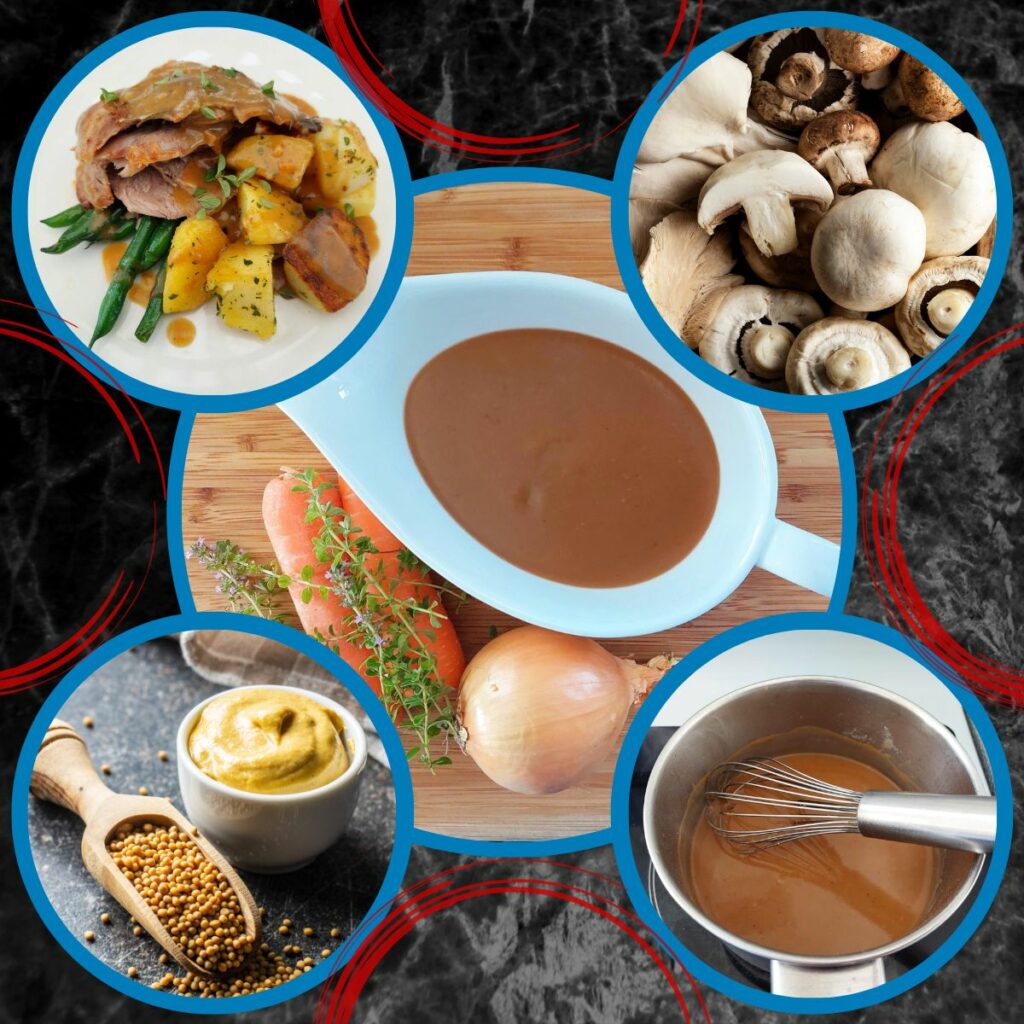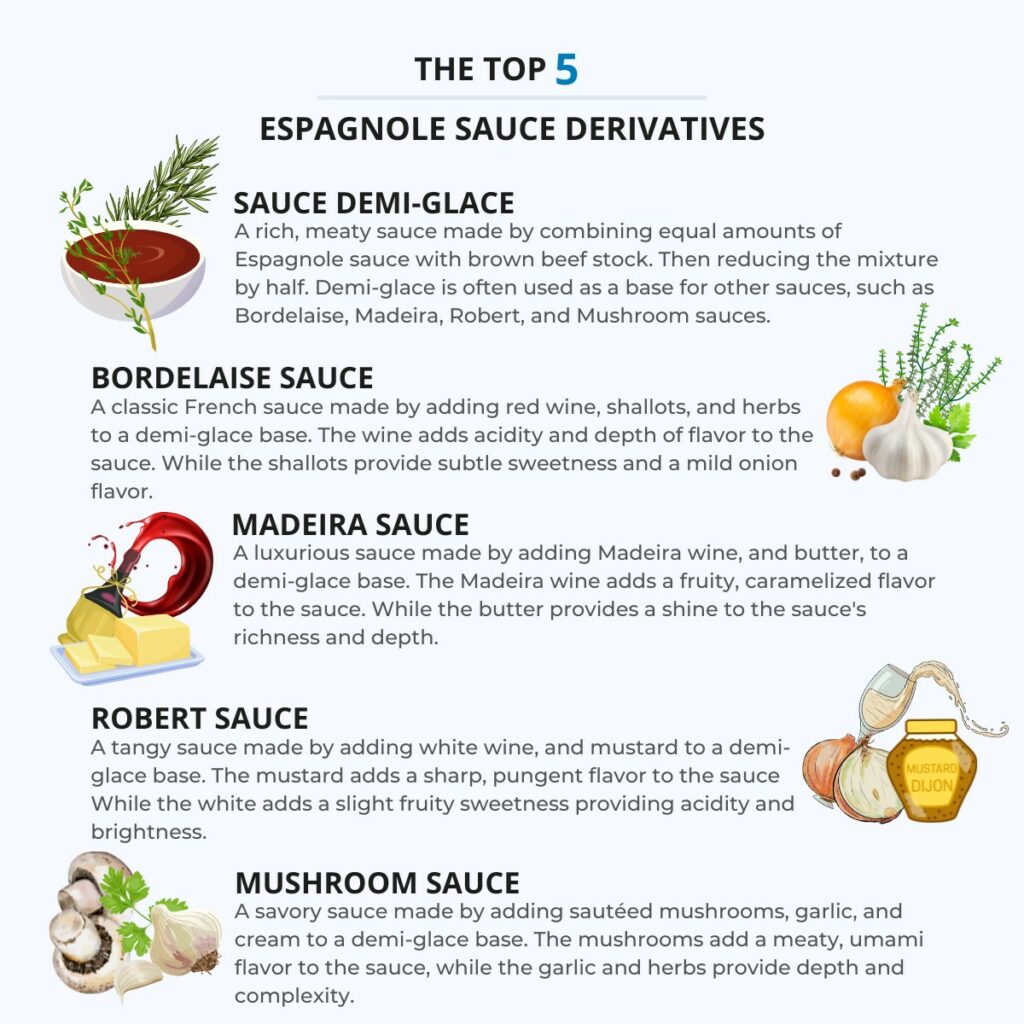Privacy Policy | Terms and Conditions | Disclosure Statement | License Policy
COPYRIGHT © 2024 | NUMBER 8 COOKING | ALL RIGHTS RESERVED.

Privacy Policy | Terms and Conditions | Disclosure Statement | License Policy
COPYRIGHT © 2024 | NUMBER 8 COOKING | ALL RIGHTS RESERVED.

Privacy Policy | Terms and Conditions | Disclosure Statement | License Policy
COPYRIGHT © 2024 | NUMBER 8 COOKING | ALL RIGHTS RESERVED.
Welcome, fellow food enthusiasts, to this saucy journey into the world of Espagnole sauce derivatives.
I am thrilled to share with you my top 5 favorite Espagnole sauce derivatives. These sauce derivatives will complete the food you cook at home.
ADVERTISEMENT CONTENT BELOW
If you’re looking for inspiration for sauce ideas keep reading. My top 5 Espagnole derivatives are what I love to cook to enhance my food.
In the blog post, we’ll explore my top 5 Espagnole sauce derivatives. Their recipes and tips that I use to get the best-tasting sauces.
From the classic Demi-glace with its meaty refined flavor. To the famous Bordelaise sauce with its delicate fruity thyme flavors.
These 5 Espagnole derivatives are so diverse and unique you can cook a different one every night and everyone would think you’ve created a completely new sauce every time.
So, follow me on this saucy journey into the world of sauce. Derivatives of Espagnole the mother of all mother sauces.

ADVERTISEMENT CONTENT BELOW
These Espagnole sauce derivatives are the perfect way to elevate any dish. This will have your guests wondering what your secret ingredient is.
Making sauces are complex and can take time. A sauce can make or break a dish. With these saucy secrets in your cooking arsenal. You’ll be well on your way to culinary greatness.
I am excited to share with you my top 5 go-to Espagnole sauce derivatives. For the most delicious and versatile sauces keep scrolling.
How to season food is an art that combines creativity, intuition, and a deep understanding of flavors. That transforms ordinary ingredients into extraordinary culinary masterpieces.
Demi-glace is one of the most popular Espagnole sauce derivatives. This full-bodied, meaty sauce is made by reducing Espagnole sauce with brown stock.
Resulting in a deep, savory flavor that is perfect for seared or roasted meat dishes. It has a slightly sweet and nutty flavor which comes from the brown roux used in Espagnole.
With a hint of fruity acidity that comes from the red wine. Making it a versatile sauce that pairs well with beef, veal, lamb, and game meats.
Chefs Pro Tip — When it comes to cooking with demi-glace, these tips are from years of cooking.
When it comes to serving demi-glace, there are endless possibilities. You can drizzle it over a perfectly cooked steak, use it as a dipping sauce for roasted vegetables, or even add some fresh cream and reduce then mix it with pasta like fettuccini, tagliatelle, or pappardelle.
Demi-glace is a sauce that can make any dish shine. Adding depth and complexity to even the simplest of meals.
Sauce Demi-glace is a must-have in any cook’s or chef’s repertoire. Its meaty, savory flavor and versatility make it the perfect sauce for a wide range of dishes. With a little patience and experimentation, you can create a demi-glace that is perfectly tailored to your tastes
Bordelaise sauce is one of the classic Espagnole sauce derivatives. That is sure to elevate any dish to new heights. As a culinary warrior, I love making Bordelaise sauce.
Bordelaise sauce has a deep, complex flavor. That is both savory and slightly sweet this is from the Espagnole, thyme, and shallots.
It also has a hint of acidity from the reduced red wine. It’s the perfect complement for red meats and game birds like duck, ostrich, or pheasant.
Chefs Pro Tip — When it comes to making Bordelaise sauce, here are a few tips to help you cook the perfect sauce.
This could cause it to split or break. When the butter separates from the sauce, it can ruin the texture and appearance of the sauce. So, gently incorporate the butter into the finished sauce for a shiny and luscious finish.
By following this approach, you’ll achieve a perfectly reduced Bordelaise sauce. That is no
Bordelaise sauce is a classic sauce and is often served with beef dishes, such as steak and roast beef. It’s also a delicious accompaniment to lamb, pork, and even game birds. In addition.
Bordelaise sauce can be used as a base for other sauces, such as mushroom Bordelaise and truffle Bordelaise. This can add an earthy flavor to the sauce. You can also add a couple of drops of lemon juice even cooked bone marrow.
Bordelaise sauce is a handy sauce to have in your culinary recipe collection. Its deep complex flavor and versatility make it the perfect sauce for a wide range of dishes. The limit to the possibilities is your imagination.

ADVERTISEMENT CONTENT BELOW
Madeira sauce another one of the Espagnole sauce derivatives is the perfect way to add a touch of elegance to a dish. Its sweet flavor that comes from the Madeira and refined flavor from the Espagnole creates a unique flavor.
Madeira sauce can be made with Espagnole. However, I prefer to use Demi-glace as it has a defined flavor and also cuts down the cooking time.
Madeira wine has the flavor of caramel, orange zest, walnut, and hazelnut. This complex wine is perfect for making sauces.
Chefs Pro Tip — These are tips that I’ve learned from years of making Madeira sauce.
Avoid reducing the wine prior to adding it to the Espagnole. As this can cause the wine to become overly sweet, potentially compromising the ultimate flavor profile of the sauce.
One of the great things about Madeira sauce is that it can be customized to suit your tastes. For a sweeter sauce, you can reduce it slightly before adding it to the Espagnole, or add a bit of honey or maple syrup.
For a tangier sauce, try adding a splash of balsamic vinegar or lemon juice. And for a spicier sauce, add a pinch of chili flakes or cayenne pepper.
Madeira sauce can be paired with pork and chicken dishes, roasted pork tenderloin, roasted chicken, and even confit chicken leg. It also pairs well with duck and wild pork.
Madeira sauce is easy to make and is a great go-to sauce when you’re having guests over. So add this one to your culinary repertoire or recipes. Its subtle sweet flavor will add that professional level to your food.
Robert sauce is one of the less common Espagnole sauce derivatives. A classic sauce that I’ve made countless times. The addition of white wine and Dijon mustard adds fruity spicy notes.
Even though Robert sauce isn’t as popular as other derivative sauces it still has a delicious flavor. There is a little more involved in making this derivative sauce, however, it is worth it.
The flavor profile of Robert sauce comes from butter, sweated onions, white wine, and Dijon mustard. This sauce is made by reducing white wine with butter and shallots.
The result is a crisp, tangy, and slightly sweet-flavored sauce. The sauce has a unique kick from the mustard that sets it apart from other sauces.
Chefs Pro Tip — When making Robert sauce here are a couple of tips that will give you the best results.
While preparing Robert sauce, there are a variety of subtle yet impactful tweaks you can make to the recipe. Consider utilizing shallots or garlic in lieu of white onion for a slightly different flavor profile.
For those looking to add a bit of heat to the sauce, swapping in hot English mustard or even wasabi can provide a spicy kick that will tantalize the taste buds.
Robert sauce is best served with grilled or broiled pork chops, pot roasted beef, and corned silverside. It is also great with seared or char-grilled steaks and pork sausages and herb-roasted vegetables.
Robert sauce is a must-have in your sauce recipe collection. Its unique flavor will stand out to your guests, who will be pleasantly surprised.
Even though this isn’t one of the classic Espagnole sauce derivatives. It still is a great sauce, the cream with the mushrooms makes it a creamy earthy flavored sauce.
The mushroom sauce complements roasted chicken, and seared or char-grilled steaks. It is also great as a topping for baked potatoes, sprinkle over some freshly chopped herbs for another flavor boost.
You can add some subtle variations by using Portobello, Oyster, or Porcini mushrooms. You can also add finely chopped fresh sage, or rosemary to the finished sauce for a herbaceous hit.
Chefs Pro Tip — Follow these tips to achieve a professional quality mushroom sauce.
To prevent the mushrooms from releasing excess water into the sauce and diluting its consistency. It is essential to thoroughly cook them beforehand.
Be sure to cook the mushrooms thoroughly before incorporating them into the sauce. As this will help maintain the sauce’s thickness and ensure that it is perfectly balanced and full of flavor.
This mushroom sauce and its versatility should become a staple in your recipe collection. The creamy earthy flavors add depth and complexity to a wide range of dishes, and its versatility allows you to use it in a variety of ways.
When it comes to mushroom sauce, it’s all about balance. The earthy umami flavors of the mushrooms and the creamy sauce can easily overpower a dish. So it’s important to use it sparingly and in moderation. A little bit of mushroom sauce can go a long way.
Espagnole sauce is a brown sauce that is considered one of the five “mother sauces” in French cuisine. It is a luxurious and deeply flavored sauce.
Crafted from a combination of brown roux, brown beef stock, and mirepoix (a blend of roughly diced onions, celery, and carrots).
The result is a meaty, savory, sauce that boasts a rich, complex taste profile and is a cornerstone of many classic sauces.
Espagnole sauce derivatives are sauces that are made by starting with the base of Espagnole sauce.
Then adding additional ingredients to create new sauces with different flavors and textures. By adding different ingredients, chefs can create a wide variety of sauces that pair well with different dishes.
The difference between Demi-glace and Espagnole is Demi-glace is a sauce made from reducing equal amounts of Espagnole sauce and beef stock, with aromatics like thyme, bay leaves, or rosemary.
The difference between the two is that Espagnole sauce is the base for Demi-glace. This means it is a derivative sauce of Espagnole and has a more concentrated flavor than Espagnole.
Demi-glace is often used as a base for other sauces or a flavor enhancer. While Espagnole sauce is typically served on its own or as a base for Demi-glace.
While you can use any type of edible mushroom for mushroom sauce. Some varieties will yield a better flavor profile than others. For example, porcini mushrooms have a meaty texture and a slightly nutty flavor.
While oyster mushrooms have a more delicate flavor and a slightly earthy taste. You can also use a mix of different mushrooms like Swiss browns and Portabellos to add complexity to your mushroom sauce.
These are my top 5 Espagnole sauce derivatives that I still used today in a variety of dishes. Each sauce has its own unique flavor profile and can transform a dish to a new level of decadence.
As a chef, experimenting with these classic sauces and their derivatives I can help you develop your own signature sauces and add your personal touch to traditional recipes.
Whether you are a professional chef or a home cook, these sauces are worth mastering to take your culinary skills to the next level.
Remember a sauce can make or break a dish. So go ahead and indulge in the complex, savory flavors of these Espagnole sauce derivatives, and let your taste buds be your guide.